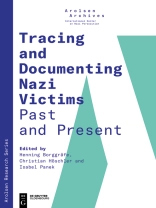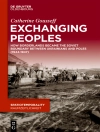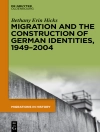After World War II, tracing and documenting Nazi victims emerged against the background of millions of missing persons and early compensation proceedings. This was a process in which the Allies, international aid organizations, and survivors themselves took part. New archives, documentation centers and tracing bureaus were founded amid the increasing Cold War divide. They gathered documents on Nazi persecution and structured them in specialized collections to provide information on individual fates and their grave repercussions: the loss of relatives, the search for a new home, physical or mental injuries, existential problems, social support and recognition, but also continued exclusion or discrimination. By doing so, institutions involved in this work were inevitably confronted with contentious issues—such as varying political mandates, neutrality vs. solidarity with those formerly persecuted, data protection vs. public interest, and many more. Over time, tracing bureaus and archives changed methods and policies and even expanded their activities, using historical documents for both research and public remembrance. This is the first publication to explore this multifaceted history of tracing and documenting past and present.
表中的内容
Tracing and Documenting Nazi Victims Past and Present – Table of Contents
Floriane Azoulay
Preface
Henning Borggräfe, Christian Höschler, and Isabel Panek
Tracing and Documenting Nazi Victims Past and Present – Introduction
Dan Stone
On the Uses and Disadvantages of ITS for History
From Early Tracing Activities to Information for Descendants
Christian Höschler and Isabel Panek
The (Early) Search for Missing Nazi Victims: Historical Precedents, Organizational Frameworks, and Methods
Linda G. Levi
Family Searching and Tracing Services of JDC in the World War II Era
Christine Schmidt
Those Left Behind: Early Search Efforts in Wartime and Postwar Britain
Maren Hachmeister
Tracing Services in Poland and Czechoslovakia after 1945: Between Humanitarian Principles and Socialist Ideology
René Bienert
Help for Survivors – Help from Survivors: Simon Wiesenthal and the Early Years of the Search for Nazi Criminals in Linz
Silke von der Emde
Caring for the Dead and the Living: DPs and the Arolsen Archives of Feelings
Zvi Bernhardt
Yad Vashem and Holocaust Victim’s Search for Family
Diane Afoumado
ITS Research at the Unites States Holocaust Memorial Museum for Descendants of Holocaust Victims and Survivors
Ramona Bräu, Kerstin Hofmann, and Anna Meier-Osiński
The New Tasks and Challenges for Tracing
Collections and Activities of Archives Dealing with Nazi Victims
Henning Borggräfe and Isabel Panek
The Arolsen Archives as an Example for the Emergence of Collections Archives after 1945
Rebecca Boehling
From Tracing and Fate Clarification to Research Center: The Role of International Players and Transnationalism in Shaping the Identity of the ITS
Kerstin Hofmann
‘It is our job to find out who did what.’ The Central Office in Ludwigsburg and Cooperation with the ITS
Tobias Herrmann
The Federal Archives and its Role in German Politics of Remembrance
Carola Lau
Institutes of National Remembrance and their Role in the Analysis of National Socialism –
An Examination of the Issues, Debates and Public Perceptions
Puck Huitsing and Edwin Klijn
Linking and Enriching Archival Collections in the Digital Age: The Dutch War Collections Network
List of Contributors
关于作者
Henning Borggräfe, Arolsen Archives; Christian Höschler, Arolsen Archives; Isabel Panek, Museum of the City of Leipzig.












